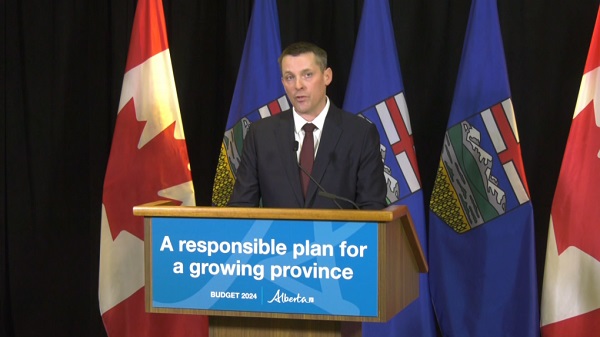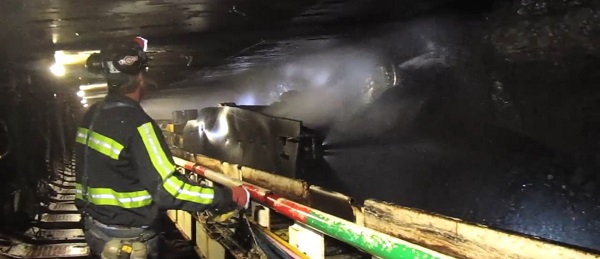Alberta
Alberta 2025 Budget Review from the Alberta Institute

The government has just tabled its budget in the Legislature.
We were invited to the government’s advance briefing, which gave us a few hours to review the documents, ask questions, and analyze the numbers before the official release.
Now that the embargo has been lifted, we can share our thoughts with you.
However, this is just our preliminary analysis – we’ll have a more in-depth breakdown for you next week.
*****
The 2025/26 Budget is a projection for the next year – what the government expects will happen from April 1st, 2025 to March 31st, 2026.
It represents the government’s best estimate of future revenue and its plan for expenditures.
In the budget (and in this email) this type of figure is referred to as a Budget figure.
*****
The actual final figures won’t be known until the 2025/26 Annual Report is released in the middle of next year.
Of course, as we’ve seen in the past, things don’t always go according to plan.
In the budget (and in this email) this type of figure is referred to as an Actual figure.
Importantly, this means that the 2024/25 Annual Report isn’t ready yet, either.
*****
Therefore, in the meantime, the Q3 2025/26 Fiscal Update, which has figures up to December 31st, 2024, provides a forecast for the 2024/25 year.
The government looks at the actual results three quarters of the way through the previous year, and uses those figures to get the most accurate forecast on what will be the final result in the annual report, to help with estimating the 2025-26 year.
In the budget (and in this email) this type of figure is referred to as a Forecast figure.
*****
Accurately estimating, and tracking these three types of figures is a key part of good budgeting.
Sometimes, the economy performs better than expected, oil prices could be higher than initially forecast, or more revenue may come in from other sources.
But, other times, there’s a recession or a drop in oil prices, leading to lower-than-expected revenue.
On the spending side, governments sometimes find savings, keeping expenses lower than planned.
Alternatively, unexpected costs, disasters, or just governments being governments can also drive spending higher than budgeted.
The best way to manage this uncertainty is:
- Be conservative in estimating revenue.
- Only plan to spend what is reasonably expected to come in.
- Stick to that spending plan to avoid overspending.
By following these principles, the risk of an unexpected deficit is minimized.
And if revenue exceeds expectations or expenses come in lower, the surplus can be used to pay down debt or be returned to taxpayers.
On these three measures, this year’s budget gets a mixed grade.
*****
On the first point, the government has indeed made some pretty conservative estimates of revenue – including assuming an oil price several dollars below where it currently stands, and well below the previous year’s predictions.
The government has also assumed there will be some significant (though not catastrophic) effects from a potential trade war.
If oil prices end up higher, or Canada avoids a trade war with the US, then revenue could be significantly higher than planned.
Interestingly, this year’s budget looks very different depending on whether you compare it to last year’s budget, or the latest forecast.
This year’s budget revenue is $6.6 billion lower than what actually happened in last year’s forecast revenue.
But, this year’s budget revenue is actually $600 million higher than what was expected to happen in last year’s budget revenue.
In other words, if you compare this year’s budget to what the government expected to happen last year, revenue is up a small amount, but when you compare this year’s budget to what actually happened last year, revenue is down a lot.
*****
On the second point, unfortunately, the government doesn’t score so well.
Expenses are up quite a bit, even though revenue is expected to drop.
According to some measurements, expenditures are increasing slower than the combined rate of population growth and inflation – which is the goal the government set for itself in 2023.
But, when other expenses like contingencies for emergencies are included, or when expenses are measured in other ways, spending is increasing faster than that benchmark.
This year’s budget expenses are $4.4 billion higher than what was actually spent in last year’s forecast expenses.
But, this year’s budget expenses are $6.1 billion higher than what was expected to happen in last year’s budget expenses.
Perhaps the bigger question is why is expenditure increasing at all when revenue is expected to drop?
If there’s less money coming in, the government should really be using this as an opportunity to reduce overall expenditures.
*****
On the third point, we will – of course – have to wait and see what the final accounts look like next year!
*****
Before we wrap up this initial analysis, there’s one aspect of the budget that is likely to receive significant attention, and that is a tax cut.
Originally planned to be phased in over the next few years, a tax cut will now be back-dated to January 1st of this year.
Previously, any income below about $150,000 was subject to a 10% provincial tax, while incomes above $150,000 attract higher and higher tax rates of 12%, 13%, 14%, and 15% as incomes increase.
Under the new tax plan, incomes under $60,000 would only be taxed at 8%, with incomes between $60,000 and $150,000 still paying 10%, and incomes above $150,000 still paying 12%, 13%, 14%, and 15%, as before.
Some commentators are likely to question the wisdom of a tax cut that reduces revenue when the budget is going to be in deficit.
But, the reality is that this tax cut doesn’t actually cost much.
We’ll have the exact figures for you by next week, but suffice to say that it’s a pretty small portion of the overall deficit, and there’s a deficit because spending is up a lot, not because of a small tax cut.
In general, lower taxes are good, but we would have preferred the government work towards a lower, flatter tax instead.
The Alberta Advantage was built on Alberta’s unique flat tax system where everyone paid the same low flat tax (not the same amount, the same percentage!) and so wasn’t punished for succeeding.
Alberta needs a plan to get back to a low flat tax, and we will continue to advocate for this at the Alberta Institute.
Maybe we can do better than just returning to the old 10% flat tax, though?
Maybe we should aim for a flat tax of 8%, instead?
That’s it for today’s quick initial analysis.
In next week’s analysis, we’ll break down the pros and cons of these decisions and outline where we might have taken a different approach.
In the meantime, if you appreciate our work and want to support more of this kind of independent analysis of Alberta’s finances, please consider making a donation here:
Alberta
CPP another example of Albertans’ outsized contribution to Canada

From the Fraser Institute
By Tegan Hill
Amid the economic uncertainty fuelled by Trump’s trade war, its perhaps more important than ever to understand Alberta’s crucial role in the federation and its outsized contribution to programs such as the Canada Pension Plan (CPP).
From 1981 to 2022, Albertan’s net contribution to the CPP—meaning the amount Albertans paid into the program over and above what retirees in Alberta received in CPP payments—was $53.6 billion. In 2022 (the latest year of available data), Albertans’ net contribution to the CPP was $3.0 billion.
During that same period (1981 to 2022), British Columbia was the only other province where residents paid more into the CPP than retirees received in benefits—and Alberta’s contribution was six times greater than B.C.’s contribution. Put differently, residents in seven out of the nine provinces that participate in the CPP (Quebec has its own plan) receive more back in benefits than they contribute to the program.
Albertans pay an outsized contribution to federal and national programs, including the CPP because of the province’s relatively high rates of employment, higher average incomes and younger population (i.e. more workers pay into the CPP and less retirees take from it).
Put simply, Albertan workers have been helping fund the retirement of Canadians from coast to coast for decades, and without Alberta, the CPP would look much different.
How different?
If Alberta withdrew from the CPP and established its own standalone provincial pension plan, Alberta workers would receive the same retirement benefits but at a lower cost (i.e. lower CPP contribution rate deducted from our paycheques) than other Canadians, while the contribution rate—essentially the CPP tax rate—to fund the program would likely need to increase for the rest of the country to maintain the same benefits.
And given current demographic projections, immigration patterns and Alberta’s long history of leading the provinces in economic growth, Albertan workers will likely continue to pay more into the CPP than Albertan retirees get back from it.
Therefore, considering Alberta’s crucial role in national programs, the next federal government—whoever that may be—should undo and prevent policies that negatively impact the province and Albertans ability to contribute to Canada. Think of Bill C-69 (which imposes complex, uncertain and onerous review requirements on major energy projects), Bill C-48 (which bans large oil tankers off B.C.’s northern coast and limits access to Asian markets), an arbitrary cap on oil and gas emissions, numerous other “net-zero” targets, and so on.
Canada faces serious economic challenges, including a trade war with the United States. In times like this, it’s important to remember Alberta’s crucial role in the federation and the outsized contributions of Alberta workers to the wellbeing of Canadians across the country.
Alberta
Made in Alberta! Province makes it easier to support local products with Buy Local program

Show your Alberta side. Buy Local. |
When the going gets tough, Albertans stick together. That’s why Alberta’s government is launching a new campaign to benefit hard-working Albertans.
Global uncertainty is threatening the livelihoods of hard-working Alberta farmers, ranchers, processors and their families. The ‘Buy Local’ campaign, recently launched by Alberta’s government, encourages consumers to eat, drink and buy local to show our unified support for the province’s agriculture and food industry.
The government’s ‘Buy Local’ campaign encourages consumers to buy products from Alberta’s hard-working farmers, ranchers and food processors that produce safe, nutritious food for Albertans, Canadians and the world.
“It’s time to let these hard-working Albertans know we have their back. Now, more than ever, we need to shop local and buy made-in-Alberta products. The next time you are grocery shopping or go out for dinner or a drink with your friends or family, support local to demonstrate your Alberta pride. We are pleased tariffs don’t impact the ag industry right now and will keep advocating for our ag industry.”
Alberta’s government supports consumer choice. We are providing tools to help folks easily identify Alberta- and Canadian-made foods and products. Choosing local products keeps Albertans’ hard-earned dollars in our province. Whether it is farm-fresh vegetables, potatoes, honey, craft beer, frozen food or our world-renowned beef, Alberta has an abundance of fresh foods produced right on our doorstep.
Quick facts
- This summer, Albertans can support local at more than 150 farmers’ markets across the province and meet the folks who make, bake and grow our food.
- In March 2023, the Alberta government launched the ‘Made in Alberta’ voluntary food and beverage labelling program to support local agriculture and food sectors.
- Through direct connections with processors, the program has created the momentum to continue expanding consumer awareness about the ‘Made in Alberta’ label to help shoppers quickly identify foods and beverages produced in our province.
- Made in Alberta product catalogue website
Related information
-

 International1 day ago
International1 day agoPope Francis has died aged 88
-

 International1 day ago
International1 day agoPope Francis Dies on Day after Easter
-

 International23 hours ago
International23 hours agoJD Vance was one of the last people to meet Pope Francis
-

 2025 Federal Election12 hours ago
2025 Federal Election12 hours agoReal Homes vs. Modular Shoeboxes: The Housing Battle Between Poilievre and Carney
-

 COVID-1912 hours ago
COVID-1912 hours agoNearly Half of “COVID-19 Deaths” Were Not Due to COVID-19 – Scientific Reports Journal
-

 2025 Federal Election12 hours ago
2025 Federal Election12 hours agoHow Canada’s Mainstream Media Lost the Public Trust
-

 2025 Federal Election12 hours ago
2025 Federal Election12 hours agoPOLL: Canadians want spending cuts
-

 Business1 day ago
Business1 day agoCanada Urgently Needs A Watchdog For Government Waste







